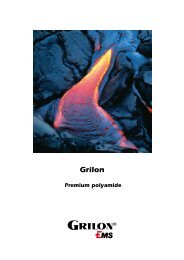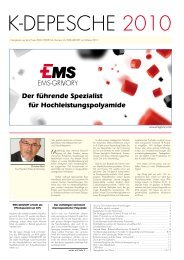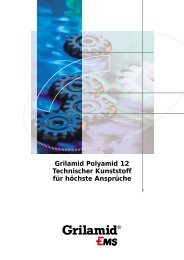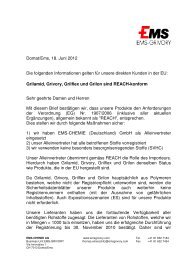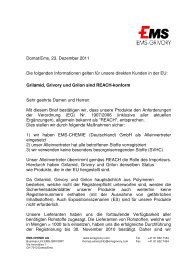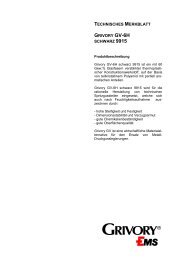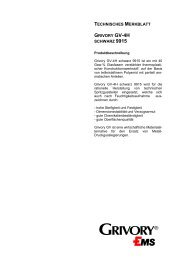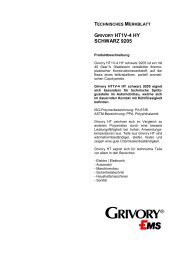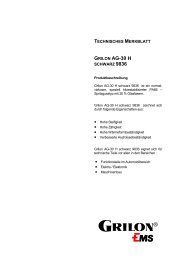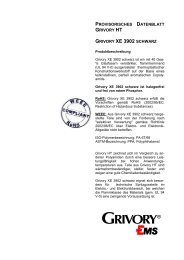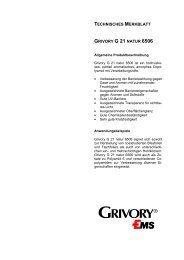technical data sheet - ems-grivory
technical data sheet - ems-grivory
technical data sheet - ems-grivory
You also want an ePaper? Increase the reach of your titles
YUMPU automatically turns print PDFs into web optimized ePapers that Google loves.
TECHNICAL DATA SHEET<br />
Grilamid LCL-3 H anthracite<br />
General product description<br />
Grilamid LCL-3H anthracite is based on a heat stabilised<br />
PA12 and 30% long carbon fibres.<br />
Grilamid LCL-3H anthracite is characterised by the<br />
following key-properties:<br />
• high stiffness and strength<br />
• very low density<br />
• excellent notched impact resistance also at low<br />
temperatures<br />
• low creep<br />
• high heat distortion temperatures<br />
• very low moisture absorption<br />
• very good dimensional stability and little warpage<br />
• excellent UV-resistance<br />
• electrically conductive<br />
• low wear and coefficient of friction<br />
The product has been designed for injection moulding of<br />
<strong>technical</strong> parts especially in the area of die-cast metal<br />
replacement of highest performance.<br />
Grilamid LCL-3H anthracite is used in the following market<br />
segments:<br />
• sports and leisure articles<br />
• mechanical engineering<br />
• household and appliances<br />
The carbon-fibres are aligned in parallel and are just as<br />
long as the pellets (usually 10 mm).
PROPERTIES<br />
Mechanical Properties<br />
Standard Unit State<br />
Grilamid LCL-3H<br />
anthracite<br />
Tensile E-Modulus 1 mm/min ISO 527 MPa cond 19.000<br />
Tensile strength at break 5 mm/min ISO 527 MPa cond 250<br />
Elongation at break 5 mm/min ISO 527 % cond 1.7<br />
Impact strength Charpy, 23°C ISO 179/1eU kJ/m 2 cond 70<br />
Notched impact strength Charpy, 23°C ISO 179/1eA kJ/m 2 cond 28<br />
Ball indentation hardness ISO 2039-1 MPa cond. 135<br />
Thermal Properties<br />
Melting point DSC ISO 11357 °C dry 178<br />
Heat deflection temperature HDT/A 1.80 MPa ISO 75 °C dry 170<br />
Heat deflection temperature HDT/C 8.00 MPa ISO 75 °C dry 160<br />
Thermal expansion coefficient long. 23 - 55°C ISO 11359 10 -4 /K dry 0.00<br />
Thermal expansion coefficient trans.. 23 - 55°C ISO 11359 10 -4 /K dry 0.50<br />
Electrical Properties<br />
Specific volume resistivity IEC 60093 Ώ m cond. < 100<br />
Specific surface resistivity IEC 60093 Ώ cond. < 50<br />
General Properties<br />
Density ISO 1183 g/cm 3<br />
dry 1.15<br />
Flammability (UL 94) 0.8 mm ISO 1210 grade HB<br />
Water absorption 23°C/sat. ISO 62 % 1.1<br />
Moisture absorption 23°C/50% r.h. ISO 62 % 0.6<br />
Linear mould shrinkage long. ISO 294 % dry 0.0<br />
Linear mould shrinkage trans. ISO 294 % dry 0.1<br />
Product-nomenclature acc. ISO 1874: PA12, MH, 14-190N, CF30
Processing information for the injection moulding of Grilamid LCL-3H anthracite<br />
In order to get the best properties out of<br />
Grilamid LCL-3H anthracite, fibre damage<br />
should be avoided as much as possible.<br />
The most important parameters for fibre length<br />
preservation are:<br />
- screw speed and back-pressure<br />
- injection speed<br />
- runner and gate geometry<br />
The following processing recommendations will<br />
give you some useful hints. For any further<br />
questions, please contact our application<br />
development experts.<br />
MATERIAL PREPARATION<br />
Storage<br />
Sealed, undamaged bags can be kept over a long<br />
period of time in storage facilities which are dry,<br />
protected from the influence of weather and where<br />
the bags can be protected from damage.<br />
Handling and safety<br />
Detailed information can be obtained from the<br />
“Material Safety Data Sheet” (MSDS) which can be<br />
requested with every material order.<br />
Handling with a vacuum pneumatic conveying<br />
system in general is possible, low transportation<br />
speeds are recommended.<br />
Drying<br />
During its manufacturing process Grilamid LCL-3H<br />
anthracite is packed with a moisture content of<br />
≤ 0.10 %. Should the packaging be damaged or the<br />
material is left open too long, the material must be<br />
dried. A too high moisture content can show by a<br />
foaming melt and silver streaks on the moulded<br />
part.<br />
Drying recommendations:<br />
Desiccant dryer<br />
Temperature: max. 80°C<br />
Time: 1 - 4 hours<br />
Dew point of the dryer: -25°C<br />
Vacuum oven<br />
Temperature: max. 100°C<br />
Time: 1 - 4 hours<br />
Drying time<br />
The moisture content for processing Grilamid LCL-<br />
3H anthracite must be lower than 0,1% .<br />
In case of long residual times in the machine<br />
hopper (more than 1 hour), a hopper heating or<br />
hopper dryer is useful.<br />
MACHINE REQUIREMENTS<br />
Grilamid LCL-3H anthracite can be processed on<br />
standard injection moulding machines. However,<br />
excessive fibre damage has to be avoided to<br />
preserve the characteristics of long fibre reinforced<br />
materials.<br />
Screw<br />
Standard polyamide screw<br />
Diameter: > 40 mm<br />
Length: 18 D - 22 D<br />
Feed zone length: 60 %<br />
Compression ratio: 2 - 2.5<br />
Flight depth metering zone: > 2 mm<br />
Processing the material on smaller screws is<br />
possible, however a higher fibre damage may<br />
occur.<br />
Shot volume<br />
The metering stroke (without decompression<br />
stroke) must be longer than the length of the back<br />
flow valve.<br />
Selecting the barrel size<br />
Shot volume = 0.5 - 0.8 x<br />
(max. shot volume)<br />
Heating<br />
At least three separately controllable heating zones<br />
are required for cylinder temperatures up to 350°C.<br />
A separate nozzle heating is necessary. The feed<br />
opening temperature must be controllable<br />
(cooling).<br />
Nozzle<br />
Shut off nozzle may damage the fibres, it is<br />
recommended to use open nozzles with an<br />
appropriate diameter.<br />
Clamping Force<br />
As a rule of thumb, the clamping force can be<br />
estimated using the following formula:<br />
Clamping Force<br />
7.5 kN 1) x projected area [cm²]<br />
1) average cavity pressure of 750 bar
TOOLING<br />
To avoid fibre damage in the tool, large flow crosssections<br />
are recommended. Furthermore, sharp<br />
edges and corners should be avoided. The tool<br />
steel should be wear and corrosion protected as for<br />
any other reinforced polyamide. In areas of high<br />
flow speeds (tunnel gate, hot runner) we<br />
recommend additional care for wear protection.<br />
Special precautions due to the long fibres are not<br />
necessary.<br />
Gate and runner<br />
To avoid damage of the fibres it is strictly<br />
recommended to use sufficient gate diameters.<br />
Sharp edges and corners should be avoided in the<br />
runner.<br />
The gating itself should not be located in areas of<br />
high stresses, as the fibres will show a random<br />
orientation around the injection gate.<br />
Gate diameter<br />
0.8 x thickest wall section of the<br />
injection moulding part<br />
Runner diameter<br />
1.4 x thickest wall section of the<br />
injection moulding part (min. 4 mm)<br />
Hot runner syst<strong>ems</strong> are well suited for processing of<br />
Grilamid LCL-3H as long as they do not have sharp<br />
corners or very small diameters. Open nozzles are<br />
preferred.<br />
Venting<br />
In order to prevent burn marks and to improve weld<br />
line strength, adequate venting of the mould cavity<br />
should be provided (venting channels on the<br />
parting surface dimensions: Depth 0.02 mm, width<br />
2 - 5 mm).<br />
PROCESSING<br />
Basic machine settings<br />
For the processing Grilamid LCL-3H anthracite,<br />
following machine settings are recommended:<br />
Temperatures<br />
Feed 80°C<br />
Zone 1 260°C<br />
Zone 2 275°C<br />
Zone 3 280°C<br />
Nozzle 275°C<br />
Tool 80 - 120°C<br />
Melt 260 - 280°C<br />
Pressures / Speeds<br />
Injection speed low to medium<br />
Hold-on pressure (spec.) 300 - 800 bar<br />
Dynamic pressure (spec.) 10-40 bar<br />
Screw speed 4 - 10 m/min<br />
Experience has shown, that especially the injection<br />
speed has a strong influence on the final part<br />
properties. In many cases, slow injection speeds<br />
showed better results.<br />
In order to reduce fibre damage, the material should<br />
be plasticised as gentle as possible. The available<br />
cooling time should fully be used as dosing time.<br />
CUSTOMER SERVICES<br />
EMS-GRIVORY is a specialist for polyamide<br />
synthesis and polyamide-processing. Our customer<br />
services are not only concerned with the<br />
manufacturing and supply of engineering<br />
thermoplastics but also provide a full of <strong>technical</strong><br />
support program:<br />
• Computer simulations<br />
• Prototype tooling<br />
• Material selection<br />
• Processing support<br />
• Specific part tests<br />
• Mould and component design<br />
We are happy to support you. Simply call one of our<br />
sales offices.<br />
The recommendations and <strong>data</strong> given are based on<br />
our experience to date, however, no liability can be<br />
assumed in connection with their usage and<br />
processing.<br />
Generated / updated: HEH20100701<br />
This version replaces all previous product specific<br />
<strong>data</strong> <strong>sheet</strong>s.<br />
www.<strong>ems</strong><strong>grivory</strong>.com



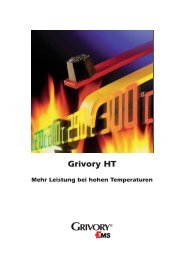
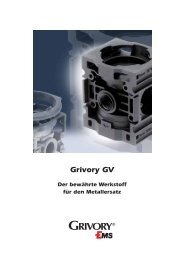
![REACH-Konformität [pdf] - ems-grivory](https://img.yumpu.com/19465850/1/184x260/reach-konformitat-pdf-ems-grivory.jpg?quality=85)
